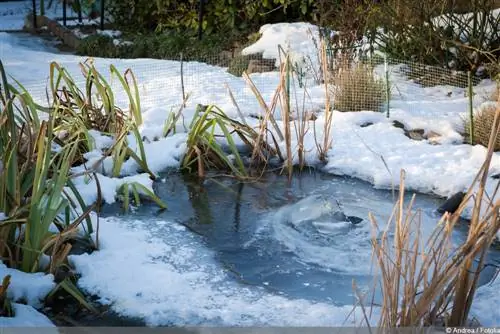- Author admin [email protected].
- Public 2023-12-17 03:39.
- Last modified 2025-01-24 12:45.
The homeland of the African lily is South Africa. Although sub-zero temperatures can occur on the southern tip of Africa, the African lily is not hardy in the sense of the German winter. However, with a little help, some varieties can survive the German winter in mild regions for a few years. However, since the number of flowers increases with the age of the plants, you should carefully consider planting out the African lily and therefore overwintering it outdoors.
Wintering
When overwintering African lilies, a distinction must be made between evergreen and leafy varieties. Because the different varieties have different requirements when it comes to overwintering. Although evergreen and leafy African lilies can tolerate temperatures of varying degrees of lowness, their biggest enemy is the wetness of German winters. Because the cold, wet weather leads to frostbite in the root ball.
Evergreen Agapanthus varieties
Evergreen African lilies retain their leaves even during the cold season. Since they cannot tolerate severe frost, they cannot overwinter planted outdoors in this country. That's why they should definitely be cultivated in a bucket. Since evergreen varieties of African lilies are not hardy, they should be moved to winter quarters before the first frost.
Tip:
Leave evergreen African lilies outdoors for as long as possible.
Winter quarters
Evergreen Agapanthus have to move to winter quarters in winter. This should be light, dry and cool. It is optimal if the winter quarters have a temperature between 0 and 7 degrees Celsius.
Tip:
The temperature must under no circumstances fall below 0 degrees Celsius, as evergreen African lilies must overwinter frost-free. Because severe frost is fatal for these varieties.
The temperatures should not be above 7 degrees Celsius. This doesn't harm the plant itself, but it will produce fewer flowers next year.
Care
Agapanthus does not need any care during winter rest. Watering and fertilizing is stopped. However, you should not leave the African lilies entirely to themselves. A regular check for pest infestation is not only recommended, but also necessary to avoid any unpleasant surprises. You should also ventilate the room regularly, preferably on frost-free days.
Foliar Agapanthus Varieties
Leaf-retracting African lilies lose their leaves in winter. Therefore, if they are cultivated in a container, they can overwinter in the dark. The temperature of the winter quarters should be as low as possible but frost-free. The plants can tolerate light frost in the short term, but only if the root soil is kept extremely dry.
Care
Leaf-retracting African lilies require no care in winter. So they are neither watered nor fertilized. The location should not be too moist either, because a dry root ball or a dry substrate is even better for the plants.
Wintering outdoors

Since African lilies can tolerate temperatures down to minus 15 degrees Celsius even for short periods of time when the soil is dry, they can also survive the German winter when planted outdoors. However, you should provide good cover, such as mulch, and protection from moisture. In addition, overwintering outdoors is only possible if the water can drain away very well, i.e. the soil is extremely permeable.
Tip:
Wintering outdoors is not really recommended. The greatest chances of success exist in mild regions, such as wine-growing regions.
Preparations
Regardless of whether leafy African lilies overwinter outdoors or indoors in a pot, you should definitely remove all yellow or dying leaves before overwintering. If these remain on the plant, this can lead to rot or mold formation.
Start of the outdoor season
For African lilies, the outdoor season begins as soon as severe frosts are no longer expected. Since they survive the cold snap during the Ice Saints, i.e. mid-May, they come back outdoors at the beginning of April. This early move outside ensures a stable leaf structure and strong flower stalks. Choose a dry, cloudy day to move. This allows the plant to get used to the new environment again. In addition, you should not immediately move Agapanthus to its sunny summer location, because the sudden blazing sun damages the plants: they get sunburn, i.e. the leaves burn in the sun. After a few days, African lilies have gotten used to the sun's rays and can move to their summer spot.
Tip:
Since Agapanthus should stay outside as long as possible in the fall, it should also be brought back outside as early as possible. That's why you can put the plants outside during the day in February or March, even on frost-free, sunny days. Since they are not hardy, you should bring the plants back indoors for the night.
Unexpected late frosts
If there are unexpected late frosts in April, you should bring the plants back inside at short notice. Alternatively, you can also protect them with a heat protection fleece.






